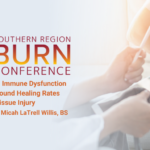Abstract | December 20, 2021
Estradiol Induces Immune Dysfunction and Reduced Wound Healing Rates After Tissue Injury
Learning Objectives
- Upon completion of this lecture, learners should be better prepared to describe a possible mechanism Estradiol in wound healing, and describes its role in the immune dysfunction following burn injury.
The American Burn Association estimates over one million people with burn injuries in the US need medical care, with around 4,500 cases ending in mortality each year. Mortality is due to bacterial infection as a consequence of severe cytokine dysregulation and impaired wound healing. Previous research has shown females have worse outcomes than males following burn injury, but the reasoning is unknown. We hypothesize that concentrations of Estrogen can create a pro-inflammatory effect in epithelial cells, which is controlled in a negative feedback loop. To test this hypothesis, we developed an in vitro cell model using human Oral Epithelial Cells (OECs) and human Airway Epithelial Cells (AECs). We simulated a wound by removing the cell insert and treating cells with concentrations of estradiol (0.1 nM, 1.0 nM & 250 nM). Images were taken at 0, 6 & 24 H and analyzed using Fiji to observe wound closure. Supernatant was removed from cells at 24 H and analyzed for IL-6 levels (a key proinflammatory cytokine linked to poor wound healing after burn) via ELISA. mRNA was isolated from cells and analyzed for IL-6, TNFα & VEGF (important regulators of wound healing) via PCR. We observed an increase in percent wound closure in the AECs, and no difference in OECs. We observed an increase in IL-6 production following stimulation with Estradiol and LPS at different rates for each cell type and corresponding reduction in TNFα and VEGF expression. We also described different Estradiol Receptors in the two cell types. Taken together, these data suggest that Estradiol affects the rate of wound healing and may play a role in profound immune dysfunction following burn. Estrogen possibly creates a negative feedback loop in epithelial cells and directly influences wound-healing closure and expression of important wound-healing associated genes.

